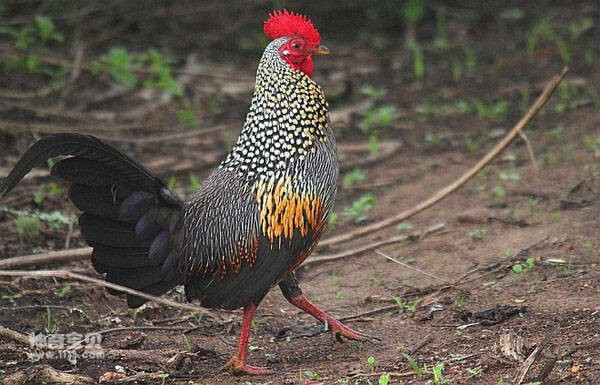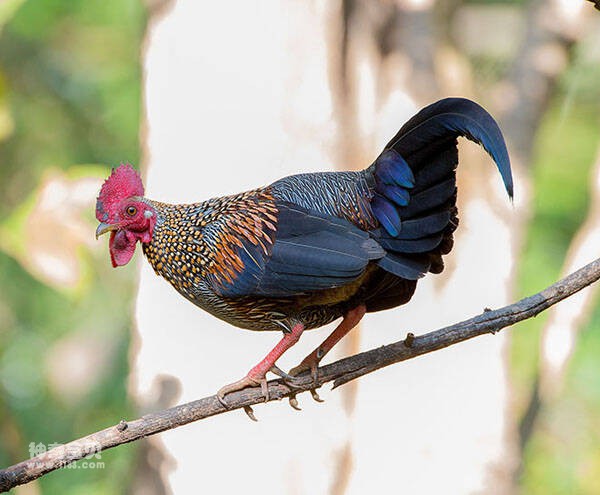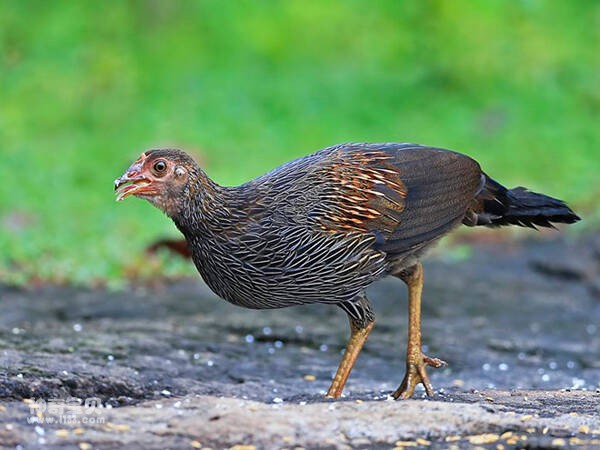Gallus sonneratii
IUCN
LCBasic Information
Scientific classification
- name:Gallus sonneratii
- Scientific Name:Gallus sonneratii,Grey Junglefowl
- Outline:Landfowl
- Family:Gallinomorpha P.family Protogallinus
Vital signs
- length:About 80 cm
- Weight:705-1136g
- lifetime:No textual research information is available
Feature
The comb is slightly dented and deep red in color, and the plumage is beautifully streaked with yellow and black
Distribution and Habitat
It is found mainly in the Indian Peninsula, extending into Gujarat, Madhya Pradesh and South Rajasthan. It also lives in the undermountain jungles of the Himalayas, where it overlaps with red roosters in the Aravalli range. But most ranges do not overlap.
Grey roosters live in a variety of environments, up to 2,400 m above sea level in the mountains. It ranges from dry secondary deciduous forests to moist evergreen woodlands, and also lives in jungles mixed with bamboo forests, most commonly on the edges of villages, near cultivated fields, and in abandoned wastelands and neglected plantations. This species is often found on hills in low mountain sections. In southern India, it can be found near the coast. Like shrubs covered with short grass, small trees and large leaved poplar forests scattered in the grass.
Appearance
The grey fowl is about 80 cm long and weighs 705-1136 grams. Compared to domestic chickens, the feet are shorter, but the wings are more developed, and the neck ranges from dark gray to black, with yellow and white stripes. The grey roost is a beautiful coloured bird, these birds have a slightly dented comb, a deep red color, and a large number of serrated but very short. The cheeks are bare and the throat has two lobes. The feathers on the long neck were a beautiful pattern of yellow and black, down the back.
The male chicken is known for the structure of its feathers, which is markedly different from other plant-eating pheasant chickens. During the breeding season, the feathers are bright and brilliant at the pinnacles of the back and wings. It widens at medium length and limits, forming what looks like a shimmering, glowing feathered surface on which the feathers are similarly inlaid. The breast feathers are black and white, with ribbed and finely defined edges. The tail feathers
Details
The Grey fowl (Gallus sonneratii) is known as Grey Junglefowl and has no subspecies.

Grey roosters, like many pheasants in the tropics, forage for food only in the morning and evening. Hiding in the woods during the hottest hours. On cloudy days, however, activities are held throughout the day. The birds are not very social, generally foraging alone or in small families of no more than five.
The diet of the grey root-fowl is diverse, including seeds of cultivated plants, young grasses, young shoots of trees, tubers, berries, figs, bamboo; They also eat insects, especially grasshoppers and termites, as well as small reptiles. In burned fields, especially like to look for the fresh growth of tender and juicy grass buds. In search of food, male chickens often take enough risks to stay away from the tree canopy, but in signs of danger, they will run and fly short distances through thick grass.

Grey roosters reach sexual maturity at the end of the second year, and the young male will usually spend the entire season with a female. However, in some cases, it may not be limited to mating with one hen during the year. Like most wild roosters, grey roosters are highly territorial. From October or November to May, the song season is longer than the actual breeding season. Grey roosts in the woods, making noisy noises in the morning and at night when there is a moon.
Grey roosters have a particularly long breeding season, coinciding with the time when male chickens moult during their breeding season. During the period 2-5, the amount of activity is very large, and the breeding period is not the same due to the wide range of distribution. In some areas nesting may begin in October, in the southernmost Indian state of Kerala Travancore is nesting in July-August. The nests were placed in a small depression, in the shade of a bush or bamboo forest, and rarely on dead trees or stumps. Females lay 3-5 eggs per litter. But some nests may have as many as seven eggs, and perhaps the result is a combination of two hens working together to lay. Incubation period is 20-21 days. Once the chicks hatch, the male will return to the nest and actively participate in pre-feeding the chicks.

Chicks are born early and can fly soon after hatching. But, before reaching this stage, they continue to learn, climbing up bushes, jumping their wings to fly a short distance, and then falling to the ground. During this time, the interaction between the female and her chicks is not the same as that of the poultry. Young chickens stay with their parents until they develop adult feathers, sometimes even more. First-year male chickens are sterile. They only gain all their adult feathers and reach sexual maturity after the second year.
Listed on the International Union for Conservation of Nature (IUCN) 2016 Red List of Threatened Species ver 3.1 - Not Threatened (LC).
Listed in Appendices I, II and III of the Convention on International Trade in Endangered Species of Wild Fauna and Flora (CITES) 2019 edition Appendix II.
Protect wild animals and eliminate wild meat.
Maintaining ecological balance is everyone's responsibility!








